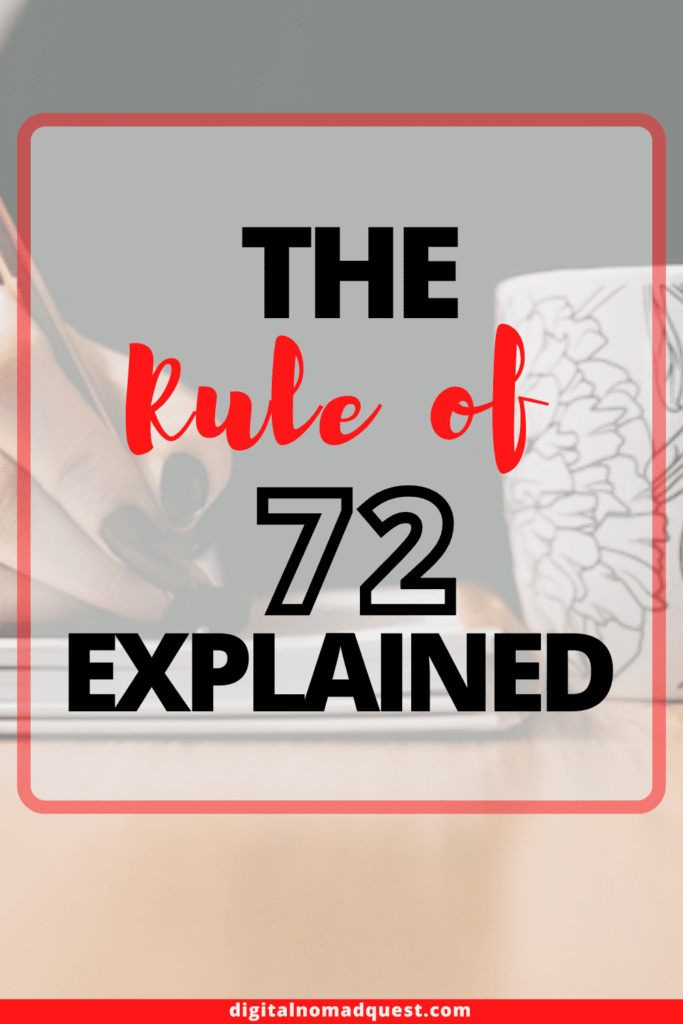What is the Rule of 72? The Rule of 72 is a formula you can use to figure out the length of time it takes to double your investment. In this video, I will give you an in-depth breakdown of how it can be used, even when reverse-engineered. Hope you enjoy!
What is The Rule of 72? (The Rule of 72 Explained)
Below is a transcription of the podcast. This transcription was taken from Otter.ai so it might not be completely accurate:
Sharon Tseung 0:02
This is the digital nomad quest podcast with Sharon Tseung. teaching people how to build passive income, become financially free and design their best lives. Hey, guys, it’s Sharon Tseung. And today we’re gonna talk about the rule of 72. So we talked about investing a lot here. And you might hear about the rates of returns on your different investments. But you might be wondering, how much can you actually earn from holding on to your investments? Like, how long would it take for an investment to really grow? But more specifically, how long would it take to double? If you’re not the best at math, the rule of 72 is actually an easy way to understand how much you can make from your investments. It’s a simple effective rule that’s used a lot to determine the amount of years needed to double an investment at a specific yearly rate of return. All you need with this is the number 72 and the interest rate. So a little bit of background, this rule was first mentioned from this Italian mathematician named Luca Pacioli. Hopefully, I’m saying his name, right. But in his discussion, he didn’t really derive or explain it. So we assume the rule may have been invented by someone else. But basically, the rule states that if you take the number 72, and divide it by the interest rate of your investment, that number is the amount of years it will take for investment to double. Now a chart from wealth simple showcases this, and it’s crazy to see that on the chart, if you have a rate of return of 3%, it would take 24 years to double your money. Whereas with 2%, it would take 36 years, that’s a whopping 12 year difference between two and 3%. Here you can see the rules not 100% accurate, but it’s pretty accurate, right, you can see that there’s a little bit of difference in the years like on 3%. It says point six years 5% It says point two years, but it’s still decently accurate. All right, now let’s say we have three investors who’ve put money into investments with different annual rates of return 3% 6% and 8%. With investments, there’s risks, so your rate of return isn’t guaranteed, but let’s just say it is here. So how would you compare these three and how much better is that 8% versus that 3%, for example. So with the first investor, you would divide 72 by the interest rate of your investment. So basically 72 divided by three equals 24 years, then for the second investor be 72 divided by six, which would equal 12 years. And then in the last scenario, you would divide 72 by 8%, which would be nine years as you can see, there’s a big difference between each percentage. Now let’s say they invested $30,000, at 24 years old, well, investor one has an annual rate of 3% return, which will take 24 years to double their money. So if you’re 24 years old, with $30,000, you’ll have $60,000, when you’re 48 years old, which is a long time to double your money. And then when you’re 72 years old, you’ll have $120,000. So age 24 be $30,000.48 would be $60,000. And then 72 would be $120,000. Now again, investor two has an annual rate of 6% return, which would take 12 years for investor to to double their money. So it’s looking like 24 years old is $30,000.36 is $60,000.48 is $120,000.60 is $240,000.72 is $480,000. And then 84 is $960,000. So that’s a lot better than the first scenario. Now investor three has an annual rate of 8%, which would take nine years for them to double their money. So 24 would be $30,000.33 be $60,000, and so on. So forth until 69 is $960,000.78 is $1,920,000. So looking at these numbers side by side, you can see a huge difference. Now using this rule, you can think how old you’re going to be how much money you would have hypothetically and what situation you’ll be in like for example, will you have kids are you trying to retire? These are questions that the rule 72 can help you with for preparing yourself financially. And by the way, if you want easy way to start investing, you can use the link down below and we will actually give you 12 Free stocks for using the platform valued up to $25,600. And that’s pretty awesome. That’s an easy way to get started on a free stock trading platform that will give you free stocks to put your head back to it. So if you can continue to save more, so you have more to invest and you’re able to increase your rate of return, you’re gonna be able to increase your net worth a lot faster. But I’m not saying to try to get higher rates of return by putting your money into high risk investments, because that’s going to make you lose your money as nothing’s guaranteed. So it’s better to invest in safer asset types like index funds or ETs and diversifying with real estate as to not put all your eggs in one basket. So for example, Spy had a 9% rate of return in the last 30 years, which is quite a large return and it tracks the s&p 500. This is a much safer investment than investing in a penny stock, for example, with potential high returns but also a large potential to completely lose their value. With all this being said it’s important to continue your financial education and continue saving as much as you can to put it back into your investments because that’s the best way to grow your net worth quickly. The cool thing is the rule of 72 applies in different ways. So one way is to flip the script right you can ask at what rate does my money have to grow to double within a specific length of time. So in order to do this instead of dividing 72 by the rate of return to get the length of time you divide 72 by the length of time to get the rate of return. So say you want to double your money in six years, 72 divided by six years equals 12% rate of return, which is what you would need. In order to accomplish this. Now, maybe you want to figure out the rate of return you need. If you want to double your money by the time your kid goes off to college, for example. So say your baby was just born and you have 18 years for you to double your investment before your kid goes to college and maybe a $20,000, and you want to invest for it to become $40,000. So let’s divide 72 by the length of time of 18 years, and then you would get 4%. So you would need a 4% annual return to make your 20,000 into $40,000. Sometimes tuition can go up to like $100,000, or $150,000. So when you’re using this rule of 72, maybe you’re like, oh, I need to have more invested in order to reach that number, the more you have invested as well as the longer you are investing for, the larger the amount you can increase your investment. Alright, so hopefully this rule of 72 helps you with your financial planning. So as you saw in the chart we showcase it’s not 100% accurate, but it’s decently accurate, right. And the rate of return is never guaranteed as investments always come with the risk. And usually the higher the rate of return, especially past 10% the riskier the investments are so that’s why I would actually focus even more on increasing the amount you can invest consistently and making sure you’re allocating your investments safely and keeping with a six month emergency funds so you don’t want to invest all of your net worth right you still want to have that emergency fund in case anything goes wrong. So make sure you’re paying yourself first investing as much as you can and then saving as well. So I hope you guys enjoyed this episode, please make sure to rate review and subscribe. It really helps our podcast grow. And thanks again. I’ll see you guys in the next one.
Transcribed by https://otter.ai


